
Solidago, commonly called goldenrods, is a genus of about 100 to 120 species of flowering plants in the family Asteraceae. Most are herbaceous perennial species found in open areas such as meadows, prairies, and savannas. They are mostly native to North America, including Mexico; a few species are native to South America and Eurasia. Some American species have also been introduced into Europe and other parts of the world.

Solidago canadensis, known as Canada goldenrod or Canadian goldenrod, is an herbaceous perennial plant of the family Asteraceae. It is native to northeastern and north-central North America and often forms colonies of upright growing plants, with many small yellow flowers in a branching inflorescence held above the foliage. It is an invasive plant in other parts of the continent and several areas worldwide, including Europe and Asia. It is grown as an ornamental in flower gardens.

Solidago flexicaulis, the broadleaved goldenrod, or zigzag goldenrod, is a North American species of herbaceous perennial plants in the family Asteraceae. It is native to the eastern and central parts of the United States and Canada, from Nova Scotia west to Ontario and the Dakotas, and south as far as Alabama and Louisiana. It grows in a variety of habitats including mesic upland forests, well drained floodplain forests, seepage swamp hummocks, and rocky woodlands.

Solidago caesia, commonly named blue-stemmed goldenrod, wreath goldenrod, or woodland goldenrod, is a flowering plant native to North America.

Solidago nemoralis is a species of flowering plant in the family Asteraceae. It is native to North America, where it is widely found in Canada and the United States. Its common names include gray goldenrod, gray-stem goldenrod, old-field goldenrod, field goldenrod, prairie goldenrod, dwarf goldenrod, and dyersweed goldenrod.

Solidago rugosa, commonly called the wrinkleleaf goldenrod or rough-stemmed goldenrod, is a species of flowering plant in the family Asteraceae. It is native to North America, where it is widespread across eastern and central Canada and the eastern and central United States. It is usually found in wet to mesic habitats.

Solidago altissima, the tall goldenrod or late goldenrod, is a North American species of goldenrod in the family Asteraceae which is widespread across much of Canada, the United States, and northern Mexico. It is common in much of its range and fairly tolerant of landscapes which have been disturbed by humans. It has become naturalized in many parts of the world.
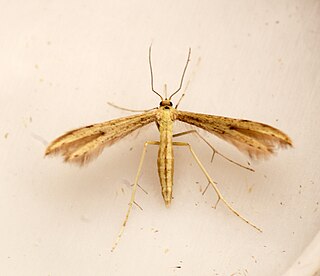
Adaina microdactyla is a moth of the family Pterophoridae first described by Jacob Hübner in 1813. Also known as the hemp-agrimony plume, it is found in Africa, Asia and Europe.

Solidago missouriensis is a species of flowering plant in the family Asteraceae known by the common names Missouri goldenrod and prairie goldenrod. It is native to North America, where it is widespread across much of Canada, the United States, and northern Mexico. It grows from British Columbia east to Manitoba, south as far as Sonora, Coahuila, Texas, and Mississippi.

Solidago odora, the sweet goldenrod, anisescented goldenrod or fragrant goldenrod, is a North American species of goldenrod within the family Asteraceae. The plant is native to the United States and Mexico, found in every coastal state from Veracruz to New Hampshire and as far inland as Ohio, Missouri, and Oklahoma. It flowers from July through October.
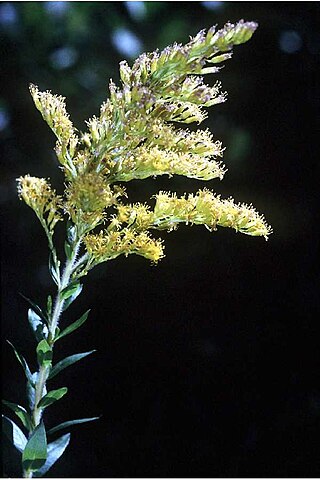
Solidago fistulosa, the pine barren goldenrod, is a plant species native to low-lying coastal areas of eastern North America. It grows in every state bordering on the Gulf of Mexico or on the Atlantic Ocean from Louisiana to New Jersey. It is generally found in bogs, along the edges of marshes, in drainage ditches, etc.
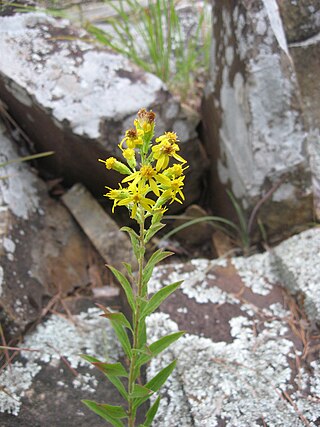
Solidago petiolaris is a North American species of goldenrod commonly called the downy ragged goldenrod. It is native to the United States and Mexico, in every coastal state from Texas to North Carolina, inland as far as southern Illinois, southern Nebraska, northeastern New Mexico, and Coahuila. Its preferred habitat is sandy areas.
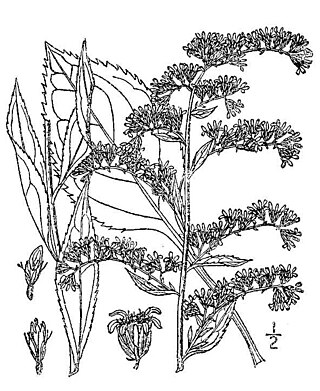
Solidago arguta, commonly called Atlantic goldenrod, cut-leaf goldenrod, and sharp-leaved goldenrod, is a species of flowering plant native to eastern and central North America. It grows along the Gulf and Atlantic states of the United States from Texas to Maine, inland as far as Ontario, Illinois, and Kansas. It is primarily found in areas of woodland openings, such as outcrops or clearings.

Solidago rigida, known by the common names stiff goldenrod and stiff-leaved goldenrod, is a North American plant species in the family Asteraceae. It has a widespread distribution in Canada and the United States, where it is found primarily east of the Rocky Mountains. It is typically found in open, dry areas associated with calcareous or sandy soil. Habitats include prairies, savannas, and glades.

Solidago mollis is a North American species of flowering plant in the family Asteraceae known by the common names velvety goldenrod, soft goldenrod or Ashly goldenrod. It is native to the central United States and central Canada, primarily the Great Plains from the Canadian Prairie Provinces south as far as Texas and New Mexico.
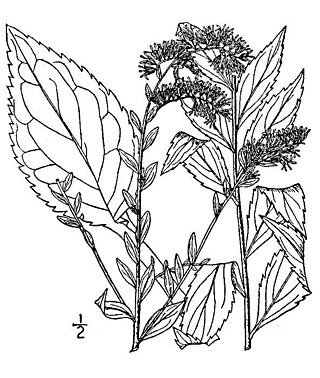
Solidago ulmifolia, commonly known as elmleaf goldenrod, is a North American species of goldenrod in the family Asteraceae. It is found in Canada and the eastern and central United States.
Gnorimoschema gallaeasterella is a moth in the family Gelechiidae. It was described by D. S. Kellicott in 1878. It is found in North America, where it has been recorded from Alberta, California, Illinois, Kentucky, Maine, Maryland, New Hampshire, Oklahoma, Quebec and Tennessee.

The goldenrod gall fly, also known as the goldenrod ball gallmaker, is a species of fly native to North America. The species is best known for the characteristic galls it forms on several species in the Solidago, or goldenrod, genus. The fly's eggs are inserted near the developing buds of the plant. After hatching, the larvae migrate to an area below the plant's developing buds, where they then induce the plant's tissues to form into the hardened, bulbous chamber referred to as a gall. E. solidaginis’s interactions with its host plant(s) and insect, as well as avian, predators have made it the centerpiece of much ecological and evolutionary biology research, and its tolerance of freezing temperatures has inspired studies into the anti-freeze properties of its biochemistry.
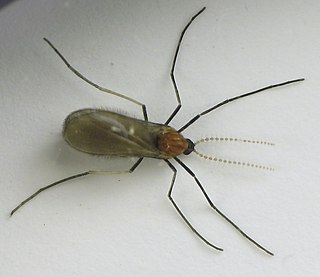
Rhopalomyia solidaginis, the goldenrod bunch gall, is a species of gall midges, insects in the family Cecidomyiidae The galls of this species have the following host species of goldenrods:Solidago altissima, Solidago canadensis, Solidago rugosa They have been found across eastern North American.

Asphondylia solidaginis is a species of gall midge (Cecidomyiidae) that induces galls on goldenrods in North America where it is widespread. It was first described by William Beutenmuller in 1907.





















